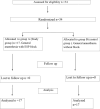Bilateral ultrasound-guided erector spinae plane block for postoperative pain relief in major traumatic spine surgery: A randomized controlled trial
- PMID: 39149750
- PMCID: PMC11323918
- DOI: 10.4103/sja.sja_694_23
Bilateral ultrasound-guided erector spinae plane block for postoperative pain relief in major traumatic spine surgery: A randomized controlled trial
Abstract
Introduction: Spine fixation surgery for traumatic vertebral fractures is associated with severe pain and is often difficult to control. Traditionally systemic opioids have been the mainstay of analgesia for these procedures, which can lead to hyperalgesia, nausea, ileus, sedation, cognitive impairment, dependence, etc., limiting usage of opioids. The Erector spinae plane block (ESPB) is a novel ultrasound-guided procedure with easily identifiable sonoanatomy. We hypothesized that a multimodal approach involving ESPB to a conventional analgesic regimen with local infiltration for patients undergoing major traumatic spine surgeries might provide better perioperative analgesia and reduce the need for postoperative opioid requirements.
Material and methods: A randomized control prospective trial was conducted on 34 ASA grade I -II patients aged 18 to 65 years who were scheduled to undergo elective posterior spine fixation surgery with ASIA B to E after traumatic spine fracture under general anesthesia. Patients were randomized to Group A which included patients who received general anesthesia with ESPB, and Group B, or the control group, included patients who received general anesthesia with systemic analgesics and postoperative local infiltration without ESPB. Intraoperative total fentanyl consumption, VAS score at 0, 3, 6, 12, 18, and 24 hours, time to activate patient-controlled analgesia (PCA) pump, total morphine consumption, and opioid-related side effects were monitored and compared in both groups.
Results: Postoperative PCA morphine consumption was significantly lower in group A patients who received ESPB than those in the control group (17.06 ± 9.59 vs 37.82 ± 9.88 P value = <0.0001). VAS scores at rest and movement at 0, 3, 6, 9, 12, 18, and 24 hours were significantly lower (P value = 0.05) in the ESPB group compared with the control group at all time points.
Conclusion: Bilateral ultrasound-guided Erector spinae plane block, when administered in traumatic spine patients undergoing spine fixation surgery, provides better analgesia with statistically decreased VAS scores and less postoperative opioid requirement.
Keywords: Analgesia; erector spinae plane block; traumatic spine fracture.
Copyright: © 2024 Saudi Journal of Anesthesia.
Conflict of interest statement
There are no conflicts of interest.
Figures
Similar articles
-
Ultrasound-Guided Techniques for Postoperative Analgesia in Patients Undergoing Laparoscopic Sleeve Gastrectomy: Erector Spinae Plane Block vs. Quadratus Lumborum Block.Pain Physician. 2023 May;26(3):245-256. Pain Physician. 2023. PMID: 37192227 Clinical Trial.
-
Effect of bilateral ultrasound-guided erector spinae plane block on postoperative pain after open lumbar spinal surgery: a double-blind, randomized controlled trial.Eur Spine J. 2023 Feb;32(2):420-427. doi: 10.1007/s00586-022-07494-3. Epub 2022 Dec 14. Eur Spine J. 2023. PMID: 36515773 Clinical Trial.
-
Comparative Study Between Dexmedetomidine with Bupivacaine and Bupivacaine Alone in Erector Spinae Plane Block for Postoperative Pain Control of Posterior Lumbosacral Spine Fixation Surgeries: A Randomized Controlled Trial.Drug Des Devel Ther. 2024 Feb 7;18:351-363. doi: 10.2147/DDDT.S444485. eCollection 2024. Drug Des Devel Ther. 2024. PMID: 38344257 Free PMC article. Clinical Trial.
-
Ultrasound-guided erector spinae plane block for postoperative short-term outcomes in lumbar spine surgery: A meta-analysis and systematic review.Medicine (Baltimore). 2023 Feb 17;102(7):e32981. doi: 10.1097/MD.0000000000032981. Medicine (Baltimore). 2023. PMID: 36800574 Free PMC article.
-
Efficacy and Safety of Bilateral Ultrasound-Guided Erector Spinae Plane Block for Postoperative Analgesia in Spine Surgery: A Systematic Review and Meta-Analysis of Randomized Controlled Trials.World Neurosurg. 2024 Jan;181:e655-e677. doi: 10.1016/j.wneu.2023.10.111. Epub 2023 Oct 28. World Neurosurg. 2024. PMID: 37898266
References
-
- World Health Organisation Spinal cord injury. 2013 Available from: https://www.who.int/news-room/fact-sheets/detail/spinal-cord-injury .
-
- Avis G, Gricourt Y, Vialatte PB, Meunier V, Perin M, Simon N, et al. Analgesic efficacy of erector spinae plane blocks for lumbar spine surgery: A randomized double-blind controlled clinical trial. Reg Anesth Pain Med. 2022;47:610–6. - PubMed
-
- Melvin JP, Schrot RJ, Chu GM, Chin KJ. Low thoracic erector spinae plane block for perioperative analgesia in lumbosacral spine surgery: A case series. Can J Anaesth 65, 2018;9:1057–65. - PubMed
-
- Singh S, Chaudhary N. Bilateral ultasound guided erector spinae plane block for postoperative pain management in lumbar spine surgery: A case series. J Neurosurg Anesthesiol. 2019;31:354. - PubMed
LinkOut - more resources
Full Text Sources




